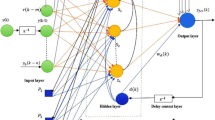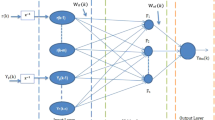Abstract
A recurrent neural network model with including time delayed effect is investigated by means of theoretical consideration and computer experiments as well. The detailed contents were already published in Neural Computing and Applications, 11 (3 and 4), pp. 137–143 (2003) by Suemitsu, Y., & Nara, S., and this report was written only for an oral presentation of this work in ICCN2019.
Access provided by Autonomous University of Puebla. Download conference paper PDF
Similar content being viewed by others
Complex dynamics could play an important role in advanced information processing and control in biological systems, particularly in neural(brain)-systems since (Skarda & Freeman, 1987; Tsuda et al. 1987; Aihara et al. 1990; Nara & Davi, 1992). Along this viewpoint, a recurrent neural network model with including time delayed effect is investigated by means of theoretical consideration and computer experiments as well. The proposed model not only works as the conventional associative memory but also enables us to embed a new kind of memory attractors which are unable to realize in the model without time delayed effect, for example, chain ring like attractors or hierarchical structure of memory attractors as shown in Fig. 1. This is attributed to the fact that time delayed effect makes the available state space expand to larger dimensions than the given number of neurons and their states. Moreover, it is discovered that the basin volume for each embedded chain ring like attractor shrinks, and unstable itinerant orbits in the outer state space of the memory attractor basins emerge, where the itinerancy in outer space could be chaotic.
Now, let us indicate a model that time delayed effect explicitly introduced in updating rule of neuron activity with discrete time and binary state scheme, represented as
where s is defined as a N-dimensional state vector consisting of binary (\(\pm 1\)) components, and F is certain sign function to describe updating of neuron activity and \(\mu \) is a parameter set included in the model. \(\tau = 0\) results in conventional model. Once this formulation of network activity is employed, then
is an independent variable (element) set in given \(\tau \), so that the total number of independent state vectors is \(\tau + 1\), and the number of independent variable is \((\tau +1) N\) in this model. In contrast, the number of independent variable is infinite when continuous time and state scheme is employed because the cardinality of real number in \(0 \le t \le \tau \) is infinitely dense, which is represented as \(\aleph \). These remarkable extensions of state-space could generate emergent complex hierarchical dynamics in activity of neural system. In actual neural systems including brain, analogue property of real number is limited to finite resolution by biological restriction, so that infinite number of variables would be reduced considerably. Even if so, however, it may account for why human brain can show extraordinary memory-capacity comparing with speculated capacity from roughly estimated number of neurons concerning memorizing and recalling function. Moreover, advanced functional processing could be realized with use of such novel hierarchical complex dynamics with including chaos.
A schematic description of new-kind attractors in high-dimensional state space, a, b: chain-ring and c: hierachical, which are able to be designed only with use of time-delayed effect [see Eq. (3])
In this paper, based on the above mentioned idea, let us only show a case employed in the previous paper (Suemitsu and Nara, 2003). It is one of selectable varieties within this scheme, in which we take \(\tau = 1\) and introduce a certain interaction between the two spaces of \(\tau = 0\) and \(\tau = 1\), as follows,
Even in this simplified model with time delay, the novel properties stated in the initial paragraph are obtained.
More detailed considerations and computer experiments to develop our ideas will be given in future.
References
Skarda, C. A., & Freeman, W. J. (1987). Behavioral and Brain Sciences, 10, 161–195.
Tsuda, I., Koerner, E., & Shimizu, H. (1987). Progress Theoretical Physics, 78, 51–71.
Aihara, K., Takabe, T., & Toyoda, M. (1990). Physics Letters A, 114(6/7), 333–340.
Nara, S., & Davis, P. (1992). Progress of Theoretical Physics, 88, 845–855.
Suemitsu, Y., & Nara, S. (2003). A note on time delayed effect in a recurrent neural network model. Neural Computing and Applications, 11(3 and 4), 137–143.
Author information
Authors and Affiliations
Corresponding author
Editor information
Editors and Affiliations
Rights and permissions
Copyright information
© 2021 Springer Nature Singapore Pte Ltd.
About this paper
Cite this paper
Nara, S. (2021). Time Delayed Effect Can Bring Novel Hierarchical Complex Dynamics to Neural Network?. In: Lintas, A., Enrico, P., Pan, X., Wang, R., Villa, A. (eds) Advances in Cognitive Neurodynamics (VII). ICCN2019 2019. Advances in Cognitive Neurodynamics. Springer, Singapore. https://doi.org/10.1007/978-981-16-0317-4_11
Download citation
DOI: https://doi.org/10.1007/978-981-16-0317-4_11
Published:
Publisher Name: Springer, Singapore
Print ISBN: 978-981-16-0316-7
Online ISBN: 978-981-16-0317-4
eBook Packages: Biomedical and Life SciencesBiomedical and Life Sciences (R0)





